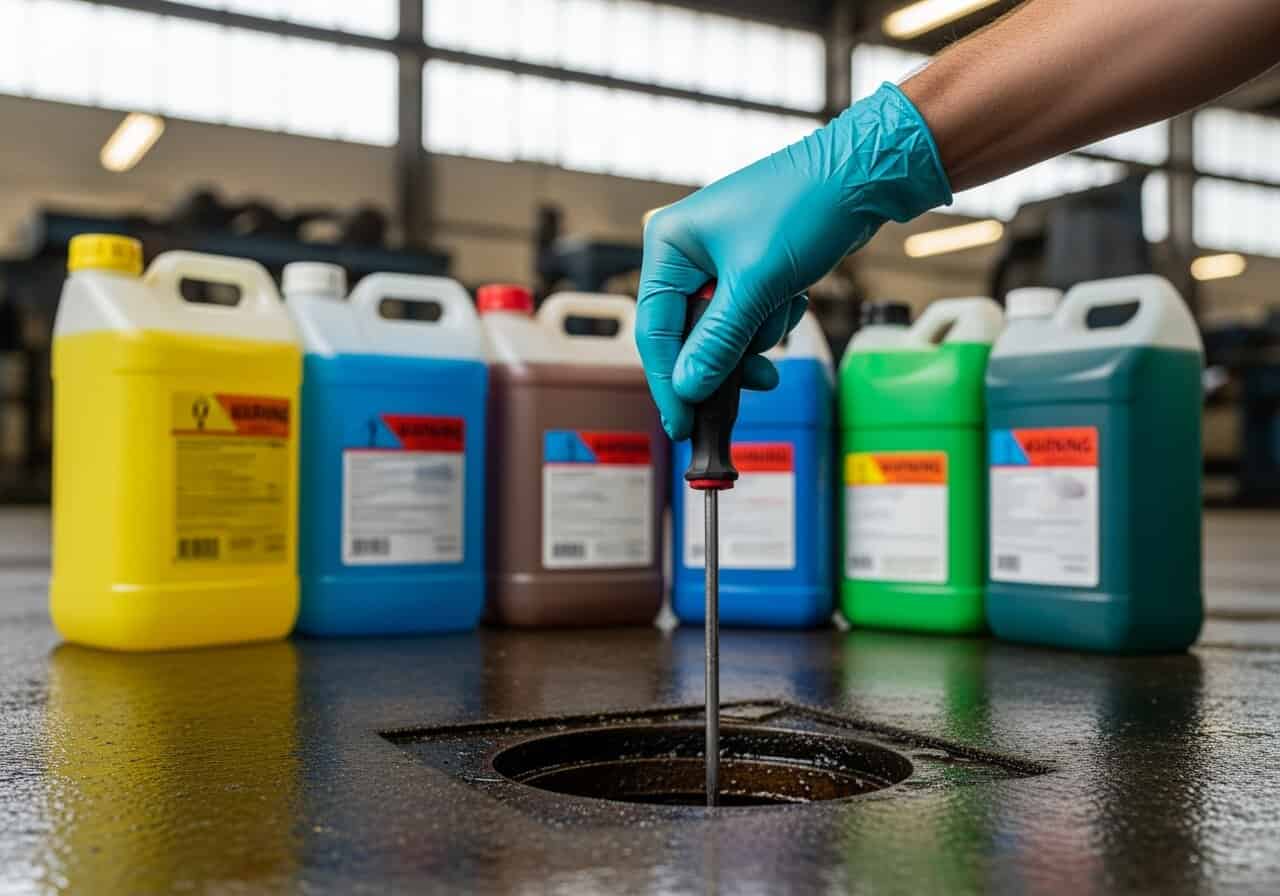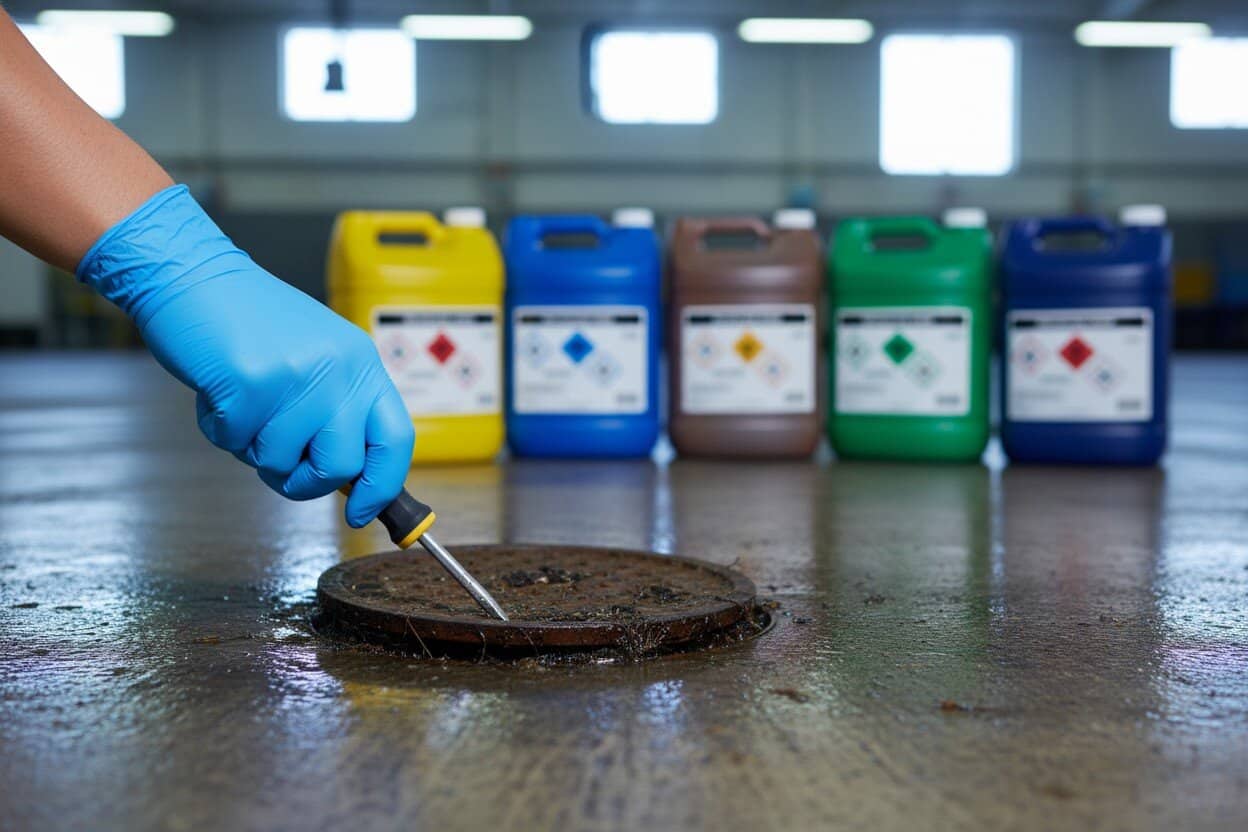Nitrile gloves are made from a man-made rubber. This material is great at resisting oil, fuel, and grease.

Here are the main points to know.
- Nitrile gloves are a type of man-made rubber.
- They resist oil better than other gloves.
- They protect your hands from oils, fuels, and grease.
- Nitrile is not made from natural rubber, so it’s safe if you have a latex allergy.
- The level of protection changes based on the glove’s thickness and quality.
- These gloves are used in jobs like car repair, food service, and factory work.
Basic of Nitrile gloves
Not all gloves are the same.
If you handle oily or greasy things, some gloves work better than others.
Nitrile gloves are a popular choice for many jobs because they are great at resisting oil.
This guide will explain what makes nitrile gloves special. We will show you why they are trusted for oily jobs and how to pick the right pair for you.
What Makes Nitrile Gloves Different?
Nitrile gloves are different for a few reasons.
They are made from a man-made rubber. This makes them strong, flexible, and good at resisting chemicals. They are often a better choice than other gloves.
Because they are man-made, they do not have the proteins found in natural rubber. This makes them a great option for anyone with a latex allergy.
They are also tough to poke holes through and create a solid barrier. It is easy to see why so many people use them.
Let’s look at what they are made of and where people use them.
What They Are Made Of
The reason nitrile gloves work so well against oil is because of what they are made of.
These gloves come from a man-made rubber called nitrile butadiene rubber (NBR). This material is naturally resistant to oils, fuels, and many chemicals.
The material does not soak up oil or fall apart when it touches it. Other materials often swell or break down.
This makes the gloves strong and hard to scrape or tear. Since they are a man-made product, they are perfect for people with latex allergies. They protect you without causing an allergic reaction.
The gloves’ oil resistance is measured by how long it takes for a chemical to get through the glove to your skin.
Compared to other gloves, nitrile provides better protection against oils.
Where People Use Them
Nitrile gloves are used in many different jobs.
You should choose them when you need good chemical protection and flexibility. They are also the right choice if you have a latex allergy. Their strength is ideal for work with oils and sharp objects.
For example, think of a car mechanic. They need to protect their hands from grease. But they also need to feel small screws and tools. Nitrile gloves are perfect for this.
Here are a few jobs that use them:
- Auto Repair: Mechanics use nitrile gloves to resist oils, grease, and other fluids.
- Food Service: Kitchen workers use them to handle oily foods and keep things clean.
- Factory Work: Workers use nitrile to protect against chemicals and rough materials.
The Science of Oil Resistance
The oil resistance of nitrile gloves is based on science.
The nitrile butadiene rubber is designed to block substances that break down other gloves.
Let’s look at the glove’s structure and compare it to other types.
How the Barrier Works
At a chemical level, the structure of nitrile rubber resists oil.
The material is designed to stand up to petroleum products. Unlike materials that absorb oil and get weak, nitrile creates a stable barrier.
This barrier slows down how fast a chemical can move through the glove. A slower rate means it takes longer for a substance to touch your skin.
With oils and grease, nitrile gloves last much longer than other disposable gloves. This makes them a dependable choice for jobs that need strong oil resistance.
Compared to Latex and Vinyl Gloves
It helps to compare your glove options.
Latex is a natural rubber. It is strong, but it performs poorly with oils and grease. Oil makes it swell up and break down.
Vinyl gloves have limited chemical resistance. They are also easier to puncture. This makes them a poor choice for tough jobs.
This comparison shows why nitrile is often the best choice.
- Nitrile: Man-made rubber. High oil resistance. High puncture resistance.
- Latex: Natural rubber. Low oil resistance. Good puncture resistance.
- Vinyl: PVC. Medium oil resistance. Low puncture resistance.
What Oils Nitrile Gloves Resist
Nitrile gloves can handle a wide range of common oils. They work against mineral oil and synthetic oil.
But they have limits.
Some strong chemicals can break down the material. It helps to know what a glove can and cannot handle.
Protection from Mineral and Synthetic Oils
Yes, nitrile gloves protect against both mineral and synthetic oils.
Their strong oil resistance works on many petroleum products and lubricants. This is why they are so useful in oily workplaces.
You can count on nitrile gloves to create a barrier between your skin and these oils. They resist these substances without getting weak.
Nitrile gloves provide good resistance to:
- Petroleum and fuels
- Vegetable oils and grease
- Many organic solvents
This wide coverage makes them a good all-around choice for oily tasks.
Limits with Some Chemicals
Nitrile gloves are strong, but they are not perfect.
Long contact with some aggressive chemicals will break down the material. Heavy oils or certain chemicals might cause the gloves to swell, soften, or crack.
If you are working with these materials, you might need a different kind of glove.
Nitrile gloves have poor resistance to:
- Ketones, like acetone
- Strong acids
- Certain other harsh chemicals
Always check a chemical resistance chart if you are unsure.
What Affects Oil Resistance
Not all nitrile gloves have the same oil resistance.
The performance depends on factors like glove thickness, texture, and quality. A thicker glove might offer more protection but make it harder to feel what you’re doing.
Let’s look at how these factors change a glove’s performance.
Thickness, Texture, and Quality
Glove thickness is a key factor.
Thickness is measured in mils. A higher number means a thicker glove. Thicker gloves offer better protection from punctures and chemicals.
But there is a balance. An 8-mil glove is great for tough jobs. A 3-mil or 5-mil glove gives you a better sense of touch for precise work.
Glove texture is also important. A textured surface gives you a better grip in wet or oily conditions.
- Thicker Gloves (like 8 mil): Offer stronger protection but can be less flexible.
- Thinner Gloves (like 3-5 mil): Offer more feeling and comfort but less resistance for long jobs.
Safety Standards and Certifications
Manufacturing standards help promise a glove’s quality. These rules make sure gloves meet specific safety requirements.
For example, medical-grade nitrile gloves must meet strict rules from the Food and Drug Administration (FDA). Industrial gloves are tested against standards from organizations like ISO.
- Medical-Grade (Exam) Gloves: Certified by the FDA for use in medical settings.
- Industrial-Grade Gloves: Made for jobs with chemicals, solvents, and grease.
These certifications confirm the gloves will perform as expected.
Choosing the Right Nitrile Glove
Picking the right nitrile gloves is important for safety.
To start, think about the difference between glove grades. They are usually either medical-grade or industrial-grade.
A healthcare worker needs medical-grade gloves. An auto mechanic needs durable, industrial-grade gloves that resist oil and punctures.
- Medical-Grade: Best for hospitals and labs.
- Industrial-Grade: Best for auto repair, factory work, and cleaning.
Matching the glove grade to your job is the first step.
Tips for Proper Use
Proper storage is key to making your nitrile gloves last.
Store them in a cool, dry place away from sunlight and heat. This helps them last for their full 3-5 year shelf life.
Always check your gloves before you use them. Look for any holes, weak spots, or stickiness. These are signs the material is breaking down.
- Inspect Before Use: Check for tears or holes every time.
- Remove Correctly: Learn to take off dirty gloves without touching the outside.
Nitrile Gloves at Work
In any job where oil is a risk, hand protection is a top priority. Oil-resistant nitrile gloves protect employees from skin problems and chemical burns.
Many industries rely on oil protection.
For example, in the automotive industry, mechanics protect their hands from motor oil and grease.
In food service, workers use nitrile gloves to handle oily foods and keep things safe.
In manufacturing, workers need protection from industrial fluids and chemicals.
Do All Nitrile Gloves have the Same Oil Resistance?
No, not all nitrile gloves offer the same protection.
The quality of oil resistance changes from brand to brand. Differences in the making process, raw materials, and thickness all affect performance.
Simply picking any nitrile glove is not enough for jobs where safety is important.
How to Read Labels
To find the true oil resistance of a glove, read its label and product data sheet.
This information tells you about the glove’s performance and recommended uses. Product sheets often include charts showing how the glove performs against specific oils.
- Look for Certifications: Check for standards from the FDA or ISO.
- Review Chemical Data: Find breakthrough times for the oils you handle.
Frequently Asked Questions
Can long contact with oil break down nitrile gloves?
Yes. While they have good oil resistance, long contact with some oils can weaken them. You should replace your gloves after heavy use with harsh chemicals.
Are oil-resistant nitrile gloves good for handling food?
Yes. Many nitrile gloves are FDA-approved for food handling. They are a safe and clean option for a kitchen.
What are the main upsides to choosing nitrile gloves for oily jobs?
Their strong oil resistance, high puncture resistance, and latex-free material are the main benefits. They offer a dependable barrier against grease and chemicals.

1 thought on “Understanding Nitrile Gloves and Oil”
Comments are closed.